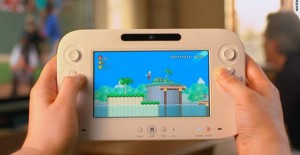Nintendo chose its E3 Expo presentation to provide a much anticipated first look at the new Wii U controller in addition to a system update and new 3D games for its $250 3DS handheld gaming device released earlier this year.
 The Wii U controller combines a 6.2-inch touchscreen, traditional inputs and motion control functionality. The wireless device will support full HD graphics (a first for Nintendo) and is backward compatible with all Wii games and accessories. Interesting features include a microphone, gyroscope, accelerometer, front-facing camera and stylus. Even though it shares a number of characteristics with other handheld devices, the Wii U controller was not designed to serve as a portable gaming device. However, users will be able to game and video chat (even without a television). By adding another screen to the home entertainment experience, Nintendo is hoping to redefine “how the TV, the game console and the Internet function and interact together.”
The Wii U controller combines a 6.2-inch touchscreen, traditional inputs and motion control functionality. The wireless device will support full HD graphics (a first for Nintendo) and is backward compatible with all Wii games and accessories. Interesting features include a microphone, gyroscope, accelerometer, front-facing camera and stylus. Even though it shares a number of characteristics with other handheld devices, the Wii U controller was not designed to serve as a portable gaming device. However, users will be able to game and video chat (even without a television). By adding another screen to the home entertainment experience, Nintendo is hoping to redefine “how the TV, the game console and the Internet function and interact together.”
According to the Nintendo press release: “Previously, video games played on a home console have been confined to the TV and offered identical viewpoints to each player in a multiplayer environment. Furthermore, watching TV and playing console games have been completely separate experiences. The new controller removes these boundaries, creating a more dynamic and fluid gaming and entertainment experience.”
Gamers can use the controller to zoom in on television images and to interact with games that appear on both the controller and TV screens. In a video demo of the system, Nintendo showed a player sending a throwing star from the controller’s touchscreen to the TV screen across the room with a swipe of his finger, as if the weapon actually flew through the air. The Wii U has similar functionality when connected to the Internet, allowing users to essentially “throw” photos or videos from the controller onto the television screen.
The dynamic of adding an additional screen to the gaming experience in the controller is difficult to explain in words, so Engadget has posted a 5-minute video demo of multi-player gaming (produced by the Nintendo Network). And Nintendo’s compelling 4-minute Wii U video from the E3 presentation is available on YouTube. It illustrates capabilities of the new device including video chats, drawing with a stylus, motion control functionality, browsing, TV interaction (even with the virtual space beyond the TV screen) and more. Additional video footage of the Nintendo E3 presentation is available on the CNET channel on YouTube.
Although specific pricing and availability was not announced at E3, the Wii U is expected to have a mid- to late-2012 release. Screen resolution was also not specified, but the display ratio is 16:9.
The company also announced a new system upgrade to its glasses-free, portable 3D device, the Nintendo 3DS (that launched March 27). Users who connect via a wireless Internet connection and install the update will have access to the Nintendo eShop, which features downloadable games and applications using a cash-based system. According to the site, gamers can access “3D games, classic games remade in 3D, and legendary titles from the Game Boy system — plus more. View webpages right from your Nintendo 3DS system, including the ability to view 3D images on the Internet where applicable.”
Nintendo also announced its initiatives to celebrate the 25th anniversary of The Legend of Zelda: “A re-mastered 3D version of The Legend of Zelda: Ocarina of Time launches for Nintendo 3DS on June 19, while Wii owners will see the arrival of The Legend of Zelda: Skyward Sword in the 2011 holiday season.”
For the duration of the E3 Expo, fans can visit the Nintendo Network online to watch developer interviews, get information about new games and see coverage from the show floor.
Related CNET article: “E3 2011: Nintendo’s new Wii U set for 2012” (6/7/11)
Related Engadget post (with press release and videos): “The Wii U controller, revealed!” (6/7/11)
Related CNN Tech article: “Nintendo unveils the Wii U system” (6/7/11)
Related USA Today article: “Nintendo unveils Wii U, with a touch-screen display” (6/7/11)
Related Yahoo! Games article: “Nintendo debuts Wii U” (6/7/11)
Related Xbit Laboratories news: “AMD and IBM Confirm Work on Chips for Nintendo Wii U” (6/7/11)
Related ABC News article (comparing announcements from Nintendo, Sony and Microsoft): “Wii 2: Nintendo Wii U Video Game Console Debuts at E3 Expo” (6/7/11)


